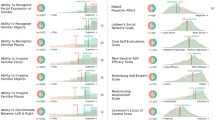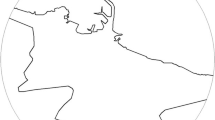Abstract
A variety of lesions in different cerebral regions may affect the human ability to orient in the environment, resulting in ‘topographical disorientation’. In a recent study, we documented the first case of Developmental Topographical Disorientation (DTD), in a person with a life-long inability to orient despite otherwise well-preserved cognitive functions, and in the absence of a cerebral injury/malformation or other neurological condition. This selective topographical disorientation was due to her inability to form a ‘cognitive map’, a mental representation of the environment, which in turn impaired her ability to orient in both familiar and unfamiliar surroundings. Here, we describe 120 new cases of DTD recruited via the internet and assessed with an online battery testing their cognitive and orientation skills. We found that people with DTD differ from matched (age, gender and education) healthy controls only in those skills confined to the orientation/navigation domain, among which the ability to form a cognitive map was the most significant factor that distinguished a person affected by DTD from control subjects.


Similar content being viewed by others
References
Aguirre GK, D’Esposito M (1999) Topographical disorientation: a synthesis and taxonomy. Brain 122(Pt 9):1613–1628
Barrash J (1998) A historical review of topographical disorientation and its neuroanatomical correlates. J Clin Exp Neuropsychol 20:807–827
Berthoz A (2001) Neural basis of spatial orientation and memory of routes: topokinetic memory or topokinesthesic memory. Rev Neurol (Paris) 157:779–789
Berthoz A, Viaud-Delmon I (1999) Multisensory integration in spatial orientation. Curr Opin Neurobiol 9:708–712
Bianchini F, Incoccia C, Palermo L, Piccardi L, Zompanti L, Sabatini U, Peran P, Guariglia C (2010) Developmental topographical disorientation in a healthy subject. Neuropsychologia Feb 5 [Epub ahead of print]
Brunsdon R, Nickels L, Coltheart M, Joy P (2007) Assessment and treatment of childhood topographical disorientation: a case study. Neuropsychol Rehabil 17:53–94
Burgess N (2006) Spatial memory: how egocentric and allocentric combine. Trends Cogn Sci 10:551–557
Burgess N, Trinkler I, King J, Kennedy A, Cipolotti L (2006) Impaired allocentric spatial memory underlying topographical disorientation. Rev Neurosci 17:239–251
Corbetta M, Kincade JM, Shulman GL (2002) Neural systems for visual orienting and their relationships to spatial working memory. J Cogn Neurosci 14:508–523
De Renzi E (1982) Disorders of space exploration and cognition. Wiley, Chichester
Greene KK, Donders J, Thoits T (2006) Topographical heading disorientation: a case study. Appl Neuropsychol 13:269–274
Grueter M, Grueter T, Bell V, Horst J, Laskowski W, Sperling K, Halligan PW, Ellis HD, Kennerknecht I (2007) Hereditary prosopagnosia: the first case series. Cortex 43:734–749
Iaria G, Incoccia C, Piccardi L, Nico D, Sabatini U, Guariglia C (2005) Lack of orientation due to a congenital brain malformation: a case study. Neurocase 11:463–474
Iaria G, Chen JK, Guariglia C, Ptito A, Petrides M (2007) Retrosplenial and hippocampal brain regions in human navigation: complementary functional contributions to the formation and use of cognitive maps. Eur J Neurosci 25:890–899
Iaria G, Lanyon LJ, Fox CJ, Giaschi D, Barton JJ (2008) Navigational skills correlate with hippocampal fractional anisotropy in humans. Hippocampus 18:335–339
Iaria G, Bogod N, Fox CJ, Barton JJ (2009) Developmental topographical disorientation: case one. Neuropsychologia 47:30–40
Incoccia C, Magnotti L, Iaria G, Piccardi L, Guariglia C (2009) Topographical disorientation in a patient who never developed navigational skills: the (re)habilitation treatment. Neuropsychol Rehabil 19:291–314
Ino T, Doi T, Hirose S, Kimura T, Ito J, Fukuyama H (2007) Directional disorientation following left retrosplenial hemorrhage: a case report with fMRI studies. Cortex 43:248–254
Lepsien J, Nobre AC (2006) Cognitive control of attention in the human brain: insights from orienting attention to mental representations. Brain Res 1105:20–31
Lundqvist D, Litton JE (1998) The Averaged Karolinska Directed Emotional Faces—AKDEF
Nyffeler T, Gutbrod K, Pflugshaupt T, von Wartburg R, Hess CW, Muri RM (2005) Allocentric and egocentric spatial impairments in a case of topographical disorientation. Cortex 41:133–143
O’Keefe J, Nadel L (1978) The hippocampus as a cognitive map. Clarendon, Oxford
Ohnishi T, Matsuda H, Hirakata M, Ugawa Y (2006) Navigation ability dependent neural activation in the human brain: an fMRI study. Neurosci Res 55:361–369
Pallis CA (1955) Impaired identification of faces and places with agnosia for colours. J Neurol Neurosurg Psychiatry 18:218–224
Stark M, Coslett HB, Saffran EM (1996) Impairments of an egocentric map of locations implications for perception and action. Cogn Neuropsychol 13:481–523
Takahashi N, Kawamura M, Shiota J, Kasahata N, Hirayama K (1997) Pure topographic disorientation due to right retrosplenial lesion. Neurology 49:464–469
Tamura I, Kitagawa M, Otsuki M, Kikuchi S, Tashiro K, Dubois B (2007) Pure topographical disorientation following a right forceps major of the splenium lesion: a case study. Neurocase 13:178–184
Tolman EC (1948) Cognitive maps in rats and men. Psych Rev 55:189–208
Wang R, Spelke E (2002) Human spatial representation: insights from animals. Trends Cogn Sci 6:376
Wilson BA, Berry E, Gracey F, Harrison C, Stow I, Macniven J, Weatherley J, Young AW (2005) Egocentric disorientation following bilateral parietal lobe damage. Cortex 41:547–554
Acknowledgments
We thank the many people (with or without DTD) who took the time to do our online tests, Tali Cherniawsky and Dylan Sargent for helping make these tests available online, and Jim Tanaka for his feedback in creating some of the tests. JJSB was supported by a Canada Research Chair and a MSFHR senior scholarship.
Author information
Authors and Affiliations
Corresponding author
Rights and permissions
About this article
Cite this article
Iaria, G., Barton, J.J.S. Developmental topographical disorientation: a newly discovered cognitive disorder. Exp Brain Res 206, 189–196 (2010). https://doi.org/10.1007/s00221-010-2256-9
Received:
Accepted:
Published:
Issue Date:
DOI: https://doi.org/10.1007/s00221-010-2256-9




